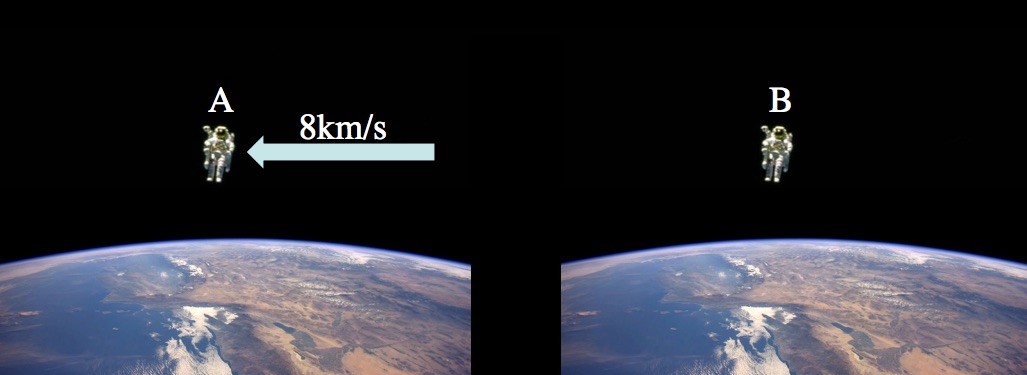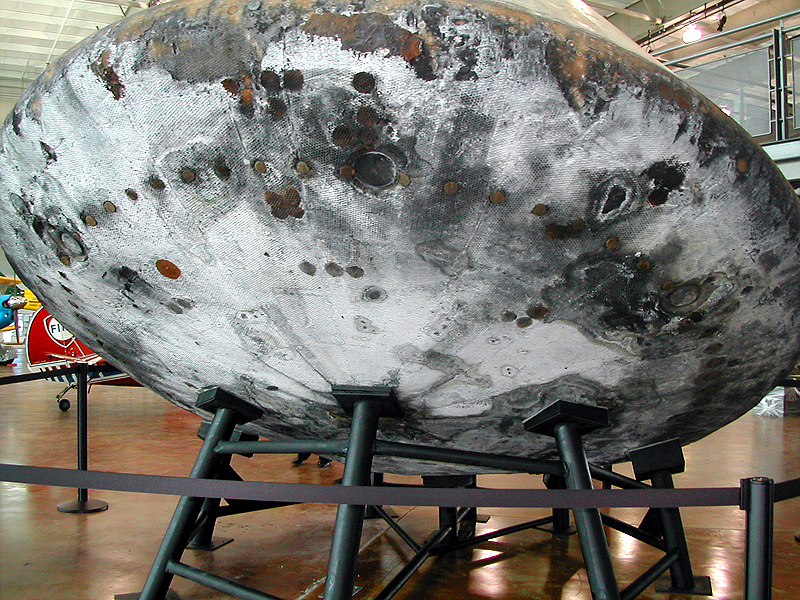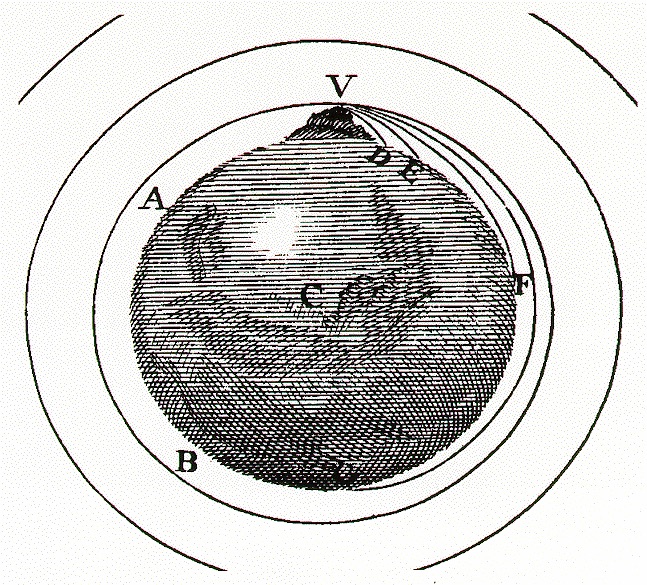Physicist: Yes and no, but mostly no.
It’s certainly possible to parachute safely to Earth from the top (or nearly the top) of the atmosphere, but this question isn’t about parachuting from space it’s about parachuting from orbit. An orbit isn’t just a matter of being very high, it’s mostly a matter of being very, very fast.
When you throw something it follows a curved path that eventually intersects the surface of the Earth (technically this is already an orbit, it just gets interrupted by stuff in the way). If you use a cannon, then the curve straightens out a bit but it still intersects the surface of the Earth, just farther away. With a really, really powerful cannon (or more likely: a rocket) you can get something moving so fast that the curve of its fall matches the curve of the Earth. When this happens the object is in orbit; a closed loop around the Earth that repeats forever.
You may have noticed that the Earth isn’t terribly curved, so it may seem that you’d need to be moving impossibly fast to follow it. That’s exactly the case: above the air but near the surface of the Earth you’d need to be moving sideways at about 8km/s. This is more than 23 times faster than the speed of sound. Not slow.

A) An astronaut in low Earth orbit, who will stay there.
B) A stationary astronaut at the same height, who will be on the ground (impact on the ground) in half an hour or so.
This 8 km/s speed corresponds to the lowest, slowest (when you hit the atmosphere) orbit. Any other orbit either won’t bring you close to the atmosphere or will do so faster (at up to about 11 km/s). Being the slowest and lowest, these roughly circular “near Earth orbits” are very popular (that is to say: cheap). Near Earth orbit is probably what you’re imagining when you think of parachuting to the Earth.

Orbits at different heights. In low Earth orbit are the International Space Station, the Hubble space telescope, and most communication satellites.
So here comes the point. You can go as fast as you want if you’re doing it in space, but when you’re measuring your speed in km per second, air starts to feel like concrete (hot concrete).

The effect of air on a “heat shield” designed to handle it (the bottom of the Apollo 11 crew capsule). A bag of meat (like a person in a spacesuit) would fare worse.
When an object plows through air at very high speeds it tends to burn, shatter, and shred. Parachutes are used for most entries and reentries, but not initially; most of the deceleration from orbit is handled by heat shields, which are a cross between parachutes and bricks (or a brick and another kind of brick). Once enough of a falling object’s speed has been shed by a heat shield (typically slower than sound, but up to a few times faster), it is then safe to deploy an actual parachute.
If you were to jump (fast) out of the International Space Station with the aim of entering the atmosphere and deploying your chute, you’d find it filled in short order then torn to ribbons shortly after. Like any falling star, you’d find yourself hot, dead, and profoundly luminous. Like icy meteors, you’d probably flash into steam and air burst before reaching the ground.
The reason you can’t parachute from orbit is simply a matter of engineering. We haven’t yet created parachutes that can survive being deployed, and then work properly, at speeds above around mach 2. At reentry speeds, which are in excess of mach 23, parachutes just can’t hold up. However, someday it may be possible. We know that the accelerations involved are survivable, and there don’t seem to be any fundamental limitations, we just need better materials and techniques. Also, for at least a little while, a spacesuit capable of reentry on its own (before the parachute has had a change to slow it) would be nice.
Merely falling from space is probably pretty easy. The highest jump so far was from 24 miles up. A jump from space is a mere four times higher. You’d need a rocket instead of a balloon, but aside from being a silly thing to do, there’s nothing stopping someone from doing it.








Though, you could, more likely than only parachuting, use a heats shielded wingsuit and helmet to decelerate in the atmosphere. If you do it right, and had enough food before to last a number of ‘bounces’ off of the atmosphere and dives back in, you could be able to come in safely.
Just make sure you use two pairs of oven mitts. After the first pair burns up, you can put the other pair on after the next ‘bounce’.
Damn I love the way you take a complex question and explain it in terms even I can understand.
So the space jump shown in the first new star trek series is not possible?
It’s entirely possible so long as you have good enough heat shielding on your spacesuit to survive re-entry; something which we very definitely cannot do right now but presumably can be done if you happen to be in the Star Trek universe.
When you say, “We haven’t yet created parachutes that can survive being deployed, and then work properly, at speeds above around mach 2”, it is true for classical atmospheric pressure like 1 atm, right ?
Assuming that we open our parachute just after jumping, shouldn’t one take into account the fact that, at 100 miles high, the atmosphere is much thinner, so the constraints on the parachute (and consequently, the slowdown induced) come into action slowly as we go down, progressively decreasing the speed until classical speed limit with a parachute is reached, avoiding us to burn or other unpleasant things ? So all in all it would be possible to parachute from outer space ?
Asking for a friend, stop looking at my parachute like that.
So… if we did a variation of the hammer and feather experiment on the moon (to show that all objects “fall” at the same speed), we could release both a hammer and a feather from the space lab and both would burn upon reentry. Or would they?
The massive hammer would certainly maintain a rapid fall rate and some significant air compression, producing heating ahead of its nose. But would the feather? Because of the light mass vs surface area, it seems the feather would rapidly decelerate and form less heated compression. Might it survive longer at least? Perhaps a feather made of heat resistant titanium barbule might survive longest of all. It does seem like the feather would succumb… else we would either be inundated with fluffy, unburned meteorites, or burned ashes thereof. Hmm, maybe we are. Ashes that is.
Q: Is it possible to parachute to Earth from orbit?
A: Yes. But it hasn’t been done yet, and the tech is still at flakey-research-toy stage.
If you are in low Earth orbit, you first need to get a bit lower. To grab slightly thicker air. You could use a drag device for this part too, as there still is a tiny bit of air up there, but it takes time. It causes orbital decay, is used to dispose of satellites and junk, and there are proposals to add sails and such to make it faster. But a deorbit burn it’s usually done using a backpack-sized rocket.
Then you need a drag device shaped for going very fast through very thin air. It’s easiest to control a shape by inflating it. Because the upper atmosphere is so thin, this doesn’t require much pressure or strength. Those are why parachutes use fickle ram air, instead of inflation, at low altitude.
These are called Inflatable Aerodynamic Decelerators, or ballutes (“balloon” + “parachute”) and inflatable aeroshells. As the drag device gets bigger, the thermal loading gets smaller, without much changing the maximum acceleration. So picture towing, or sitting inside of, a big cool balloon (building sized), or behind a smaller hotter upside-down umbrella. There have also been proposals and attempts to use variously shaped inflated wings.
That gets rid of your orbital velocity. Then you do the equivalent of a high altitude balloon jump. And there you are, feet in mud.
The traditional small blunt rigid aeroshells with a heat shield, are a mature and reliable technology. So ballutes and inflatable aeroshells haven’t gotten much investment. A few decades of research tests, most of which variously fail. They will be needed for hypothetical future reentry of larger-than capsule payloads, but that’s some years away. For now, their development is on the usual multi-decade glacial creep installment plan. Their first real use may be to recover cubesats. And Kerbal Space Program.
A Survey of Ballute Technology for Aerocapture (2005) https://solarsystem.nasa.gov/docs/54_rohrschneider.ppt.pdf
A Historical Review of Inflatable Aerodynamic Decelerator Technology Development (2010) http://soliton.ae.gatech.edu/labs/ssdl/papers/conferencePapers/IEEE-2010-1276.pdf
That was a fun research question — thanks!
Since a human in a spacesuit is much lighter than an Apollo capsule, wouldn’t a much smaller heat shield be required? Due to the vary hot air passing the windows of the space shuttle when it was flying, a teardrop capsule would be needed, with an oxygen supply since the spacesuit supply is limited. Rather than trying to exit the capsule when speed has decreased, the astronaut can ride it down, Larger parachutes are then needed but parachutes are fairly inexpensive. Perhaps some of these capsules, for 2 people and equipped with small rocket motors to enable them to reach the atmosphere should be attached to the ISS for emergency evacuation. They don’t need any internal equipment except for the oxygen and the parachute release mechanism
Slowest, lowest orbit?? The lower you are the faster the orbit… unless it’s an elliptic orbit and you’re talking about the speed at the perigee.
@Zapp
You’re exactly right. I had meant to specify “when you hit the atmosphere” (it’s fixed). In any higher or more elliptical orbit you’ll be moving faster at perigee.
What about a geosynchronous orbit? Wouldn’t that be the same as the jump from the balloons?
Few corrections:
1. You can’t jump from the space station to Earth, the orbital mechanics don’t work this way.
2. As pointed out above, if you are in orbit, you are moving very fast and cant parachute down to Earth, but if a rocket (for example) brings you straight up from Earth to the same altitude as objects in orbit (80-100 km) but your velocity relative to Earth is small, then you can. First, you would have to go through the free-fall phase (remaining in your space suit all the time) until you reach a terminal velocity in the thicker atmosphere, and then you would deploy your parachute.
The only concern is, you would start to accelerate 9.8 meters per second all this time, and the thick atmosphere is a relatively thin layer, so our space jumper would experience sudden deceleration and high g-forces to the point of loss of consciousness, so the parachute deployment should be automatic.